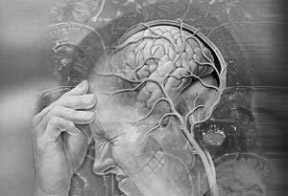- Gamma Knife
- Questions to Ask Your Doctor
- Unruptured Aneurysm
- Ruptured Aneurysm
- Clipping
- Occlusion and Bypass
- Endovascular Embolization / Coiling
- Flow Diversion
- Onyx Liquid Embolic System
- Should I Get a Second Opinion?
- Treating Physicians
Ruptured Aneurysm
An aneurysm is created when blood flows collide with artery walls and weaken them. Over time those weakened walls stretch out and form an aneurysm until it eventually bursts. A ruptured aneurysm (patient has already experienced a hemorrhagic stroke, SAH), generally requires treatment as soon as possible due to the high re-bleeding rate. Treatment options of the SAH patient are the same procedures (coiling and clipping) as for unruptured aneurysms, however, the decision is made by the attending physician as the patient is often unconscious or unable to participate in the decision-making. Treatment time and option decisions are made based on similar criteria: size, location and shape of the aneurysm and the added factors of the hemorrhage as well as the patient’s overall medical condition. One caution the family of a ruptured aneurysm patient might want to take at this juncture is to ensure that both an interventional radiologist and a neurosurgeon consult over the case as time and the patient’s condition permit. In some cases either technique could be used, and the recommendation on how to proceed will be influenced by a number of considerations including, the age and condition of the patient and the experience and skills of the attending physicians.
- Clipping
- Occlusion and Bypass
- Endovascular Embolization or Coiling
- Pipeline Embolization
- Onyx Liquid Embolic System (Onyx HD-500)
Once a hemorrhage has occurred, several consequences might develop.
Possible Impairments of a Ruptured Brain Aneurysm/AVM
50% of those who survive a ruptured brain aneurysm or AVM will have some type of permanent disability

- Verbal memory loss – up to 60% will lose their recall of some or many words
- Visual memory loss – up to 50% will not be able to remember what things look like
- Short and long term memory loss – up to 60% will have disruption in short or long term memory formation and recall
- Executive function loss – up to 76% will have impaired problem solving or decision making skills or a loss of inhibition or attention span
- Language impairment – up to 75% will have speaking impairments (this refers to physical difficulties in speaking and forming words)
- Self-care limitations – 12% or more will struggle to feed, dress, groom, bathe or use the toilet
- Daily living limitations – up to 93% will have difficulty with driving, managing finances, shopping and housekeeping tasks
- Work limitations – up to 94% are unable to return to their previous job and those that do return cannot assume the same responsibilities or work as many hours
- Quality of life – more than 90% reported diminished quality of life
- Depression – more than 50% will suffer ongoing depression after recovery
- Anxiety – up to 54% will suffer chronic anxiety
- Sleep disorders and fatigue – up to 45% will have disrupted sleep patterns and/or chronic fatigue or insomnia that are persistent throughout their life
- PTSD – up to 37% of survivors suffer symptoms consistent with post-traumatic stress disorder
For online support, please visit these groups, sponsored by The Joe Niekro Foundation
Common Questions
Upcoming Events
News Room
Connect with Us
- Subscribe to our Knuckle-Up Newsletter
- Become a Fan on Facebook
- Follow us on Twitter
- Follow us on Instagram
- Join our Online Aneurysm/AVM Support Group
- Join our Online Parents Support Group
- Join our Online Young Adult Survivor’s Support Group
- Join our Online Aneurysm/AVM Caregivers Support Group
- Join our Online Honoring the Taken Support Group
- Support Group Locations
